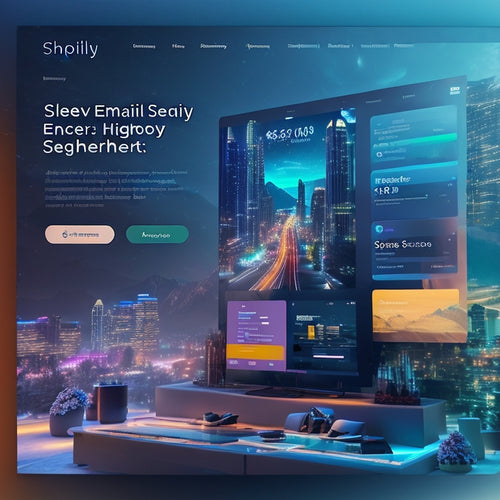
7 Best Online Course Creation and Delivery Tools
Share
You're looking for the best online course creation and delivery tools to take your e-learning to the next level. You'll want tools that help you create engaging video lessons, build interactive quizzes, and design professional course templates. Then, you'll need a platform to sell your courses, track student progress, and host live sessions seamlessly. Automated course delivery workflow is also a must. From learning management systems to customizable templates, you'll discover the top tools to streamline your online course creation and delivery process. Now, explore the top 7 tools to revolutionize your e-learning experience.
Key Takeaways
• Choose a course creation tool that allows for engaging video lessons with captions and subtitles for diverse learning styles.
• Select a platform that offers interactive quiz creation with real-time feedback and multimedia options for enhanced engagement.
• Opt for a tool that provides customizable, professional course templates with mobile-responsive design for a seamless experience.
• Consider a platform that integrates with popular learning management systems and online course marketplaces for wider reach.
• Ensure the chosen tool provides data-driven insights for student progress tracking and course optimization.
Create Engaging Video Lessons
You can capture your students' attention and convey complex concepts more effectively by incorporating high-quality, engaging video lessons into your online course. To achieve this, it's crucial to plan and execute your video content strategically.
Start by developing a detailed storyboard, outlining the sequence of events, and highlighting key takeaways. This will help you visualize the flow of your video and guarantee it aligns with your learning objectives.
Next, focus on video editing techniques that enhance the viewing experience. Use a mix of visuals, animations, and shifts to break up the content and maintain student engagement. Ensure the audio is clear and sharp, with minimal background noise or distractions.
Consider adding captions or subtitles to cater to different learning styles and improve accessibility. By investing time and effort into storyboard planning and video editing techniques, you can create video lessons that are both informative and entertaining, ultimately leading to better student outcomes and a more effective online course.
Build Interactive Quizzes Easily
When building interactive quizzes, you'll want to make the process as seamless as possible.
That's why you'll appreciate tools that simplify quiz creation, allowing you to focus on crafting engaging questions and incorporating multimedia elements that enhance the learning experience.
Quiz Creation Made Simple
Quiz Creation Made Simple
By leveraging advanced quiz creation tools, instructors can design and deploy interactive quizzes with ease, streamlining the assessment process and enhancing the overall learning experience. You can create engaging quizzes that test learners' knowledge and understanding, without requiring extensive programming or design expertise.
| Feature | Benefit |
|---|---|
| Drag-and-drop interface | Easily create quizzes with a user-friendly interface that requires no coding |
| Customizable templates | Create quizzes that match your brand and style with customizable templates |
| Multi-question types | Include a variety of question types, such as multiple-choice, true/false, and open-ended questions |
| Real-time feedback | Provide learners with instant feedback and assessment results |
With advanced quiz creation tools, you can focus on what matters most - creating high-quality, interactive assessments that promote learner engagement and understanding. By simplifying the quiz design process, you can create more quizzes in less time, and make data-driven decisions to improve your course content.
Engage With Multimedia Options
Beyond text-based quizzes, incorporating multimedia options into your assessments can further boost learner engagement and knowledge retention.
You can create interactive quizzes that include audio engagement, such as voiceovers or podcasts, to cater to auditory learners.
Interactive slides with gamification elements, like points, badges, or leaderboards, can also motivate learners to participate and compete.
Additionally, you can use visual storytelling techniques, like images, videos, or animations, to convey complex concepts in an engaging and memorable way.
To take it to the next level, you can use tools that allow you to create branching scenarios, where learners' responses determine the next step in the quiz. This simulates real-world situations and encourages critical thinking.
You can also add hotspots, drag-and-drop interactions, or matching games to make the quiz more engaging and fun.
By incorporating these multimedia options, you can create quizzes that aren't only informative but also entertaining, increasing learner engagement and participation.
With the right tools, you can create quizzes that are both effective and enjoyable, making learning a more rewarding experience.
Design Professional Course Templates
When designing professional course templates, you'll want to think about the importance of customizable template options that allow you to tailor your course's look and feel to your specific needs.
You'll also need to apply visual hierarchy principles to make sure that your content is organized in a clear and logical manner, making it easy for learners to navigate.
Customizable Template Options
You can create a professional-looking course effortlessly by utilizing customizable template options, which offer pre-designed layouts and elements that can be adjusted to suit your brand and teaching style. This allows you to focus on what matters most - creating high-quality content that resonates with your learners.
Customizable template options empower you to make design customizations that improve the user experience. You can select from a variety of templates that cater to various instructional design requirements. For example, you can utilize templates that facilitate content personalization, enabling you to customize your content to meet the diverse needs of your learners.
| Template Feature | Benefits |
|---|---|
| Pre-designed layouts | Saves time and effort in designing a course from scratch |
| Customizable colors and fonts | Enhances brand consistency and visual appeal |
| Drag-and-drop functionality | Easy to use, even for those without design expertise |
| Mobile-responsive design | Guarantees a seamless learning experience across devices |
| Instructional design guidance | Provides structure and support for effective content creation |
Visual Hierarchy Principles
By applying visual hierarchy principles to your course template design, you can create a clear and organized structure that guides learners' attention and facilitates effective knowledge retention. A well-designed visual hierarchy helps you prioritize content, direct learners' focus, and create a seamless learning experience.
To achieve this, you'll need to balance typography basics, such as font sizes, styles, and line spacing, to create a clear information architecture.
Color psychology also plays a vital role in visual hierarchy. By strategically using colors that evoke emotions, convey meaning, and create contrast, you can draw learners' attention to key concepts, highlight important information, and create visual interest.
For instance, using a bold, bright color for headings can help differentiate them from body text, making it easier for learners to scan and absorb information. By carefully considering the visual hierarchy of your course template, you can create an engaging, intuitive, and effective learning environment that supports your learners' success.
Branding Consistency Matters
Consistency in branding elements, such as logos, color schemes, and typography, is essential in creating professional course templates that reflect your brand's identity and establish a sense of cohesion throughout the learning experience. You want your learners to instantly recognize your brand and feel comfortable navigating your course.
To achieve this, you need to focus on visual branding, making sure that your templates align with your marketing strategies.
Here are three key takeaways to keep in mind:
-
Define your brand style guide: Establish a clear guide outlining your brand's visual elements, including logos, color schemes, and typography.
-
Use consistent imagery: Select images that resonate with your brand's tone and style, and use them consistently throughout your course templates.
-
Apply your brand's voice and tone: Make sure your course content reflects your brand's voice and tone, creating a cohesive and engaging learning experience.
Sell Courses on Custom Platforms
When you decide to sell courses on custom platforms, you have three popular options to take into account: learning management systems (LMS), online course marketplaces, and bespoke e-learning platforms. Each has its strengths, and the right choice depends on your specific needs and goals.
With platform integration, you can seamlessly connect your course content to your chosen platform, ensuring a smooth user experience. You can also customize your course to fit your brand, making it more engaging and effective.
To maximize your course's earning potential, you need to develop effective marketing strategies. This includes identifying your target audience, creating compelling promotional materials, and leveraging email marketing and social media campaigns.
Course monetization is also essential, and you can achieve this through various revenue models, such as subscription-based, one-time payments, or tiered pricing. By combining the right platform with a solid marketing strategy, you can increase your course's visibility, drive sales, and ultimately, boost your revenue.
Track Student Progress Effortlessly
You can guarantee a more effective learning experience and increase student engagement by tracking student progress effortlessly, which also enables you to identify areas where your course content may need improvement. By leveraging the right tools, you'll be able to monitor student performance, identify knowledge gaps, and make data-driven decisions to optimize your course content.
Here are three key benefits of tracking student progress:
-
Data-driven insights: Get access to actionable data analytics that help you understand how students interact with your course content, allowing you to refine your teaching strategy and improve student retention.
-
Personalized learning: Track student progress to identify areas where individual students need extra support, enabling you to provide targeted interventions and personalized feedback.
-
Course optimization: Use progress tracking data to identify areas of your course that need improvement, refining your content to better meet the needs of your students and increase overall student engagement.
Host Live Sessions Seamlessly
Host Live Sessions Seamlessly
Hosting live sessions seamlessly is essential for creating an immersive and engaging learning experience, allowing instructors to connect with students in real-time and foster a sense of community. You can achieve this by leveraging tools that support interactive activities, promoting student engagement and encouraging real-time feedback.
| Tool | Features | Benefits |
|---|---|---|
| Zoom | Video conferencing, screen sharing, chat | Enables participant interaction and real-time feedback |
| BigBlueButton | Virtual whiteboard, polls, and quizzes | Fosters student engagement through interactive activities |
| Google Meet | Video conferencing, screen sharing, recording | Allows for seamless live sessions and easy recording |
When choosing a tool, consider your specific needs and the type of interactions you want to facilitate. Do you want to conduct live Q&A sessions or host virtual office hours? By selecting the right tool, you can create a seamless and engaging experience for your students, increasing their participation and motivation.
Automate Course Delivery Workflow
Automating your course delivery workflow allows you to streamline routine tasks, freeing up time to focus on high-impact activities that drive student success. By leveraging automation, you can optimize efficiency, reduce manual errors, and guarantee a seamless learning experience for your students.
To get started, consider the following key areas to automate:
-
Course enrollment and onboarding: Automate the process of enrolling students, sending welcome emails, and providing course materials to guarantee a smooth start.
-
Lesson scheduling and reminders: Use automation to schedule lessons and send reminders to students, keeping them engaged and on track.
-
Progress tracking and feedback: Automate the process of tracking student progress, providing personalized feedback, and identifying areas where students need extra support.
Frequently Asked Questions
Can I Use My Own Domain for Custom Course Platforms?
You can definitely use your own domain for custom course platforms, gaining full control and flexibility. This setup offers custom domain benefits, such as increased professionalism and brand consistency, while allowing platform flexibility to tailor the learning experience.
Do I Need to Know How to Code for Quiz Customization?
"No, you don't need to be a coding wizard to customize quizzes; many platforms offer drag-and-drop quiz design tools, allowing you to focus on crafting engaging questions, not writing complex code."
Are There Any Limits to the Number of Students I Can Enroll?
You won't face limits on student enrollment, but you'll need to guarantee course scalability to maintain student engagement and retention, while also adapting marketing strategies to accommodate growing demand without compromising performance.
Can I Integrate My Course With Existing Learning Management Systems?
As you scale your course empire, you'll be relieved to know you can seamlessly integrate your course with existing learning management systems, accessing a world of LMS compatibility and custom domain setup options for platform branding.
Are There Any Discounts for Annual Course Creation Tool Subscriptions?
You'll likely find discount codes for annual subscriptions, offering cost savings. Research pricing plans carefully, as they often include benefits like priority support, extra storage, or advanced features, making your investment more valuable.
Related Posts
-

What Aspect Ratio Are Shopify Videos
This article investigates the aspect ratio used in Shopify videos. It explores the benefits of selecting an appropri...
-

Optimize Your Shopify Store With Automated Tagging
This article explores the optimization of Shopify stores through the implementation of automated tagging. Shopify ta...
-

Top Shopify Email Marketing Solutions for 2023
This article presents an overview of the top Shopify email marketing solutions for the year 2023. The focus is on id...


